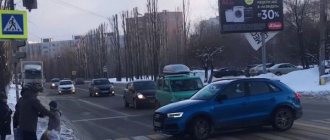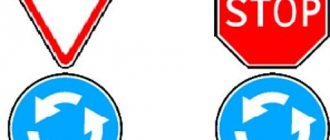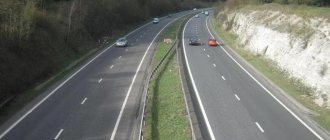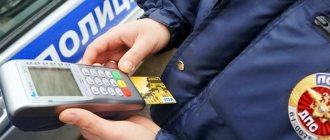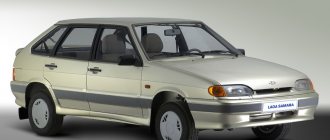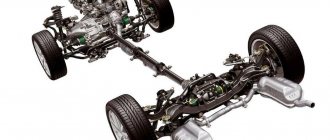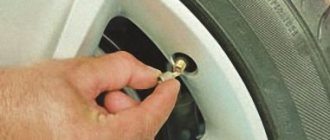Unfortunately, the intersection is often the only place where the driver can turn his car around to move in the opposite direction.
Therefore, performing such a maneuver always poses a greater danger than turning around somewhere where the solid marking lines break.
There are practically no special rules regulating this maneuver; we can only talk about how to correctly perform a U-turn at intersections.
When entering an intersection of roadways in order to turn around, the driver must be more collected so as not to “expose himself” - someone who likes to watch various accidents on YouTube will be able to notice how often collisions occur even when simply driving through intersections in a straight line.
Rules for turning around at a signalized intersection
If you approach an intersection and decide to make a U-turn, then such a maneuver must be carried out in accordance with special rules. In most cases, drivers make U-turns at signalized intersections (minimum likelihood of an accident). When turning around at a regular signalized intersection, you must adhere to the following rules:
A turn must be made within the intersection in accordance with the markings and road signs.
- Before performing the maneuver, adhere to the rules for changing lanes - take the left lane and turn on the left turn signal.
- You need to start the maneuver at the permission signal.
- When performing a maneuver, it is advisable not to drive further than the middle of the intersection.
- When performing a maneuver, the vehicle must not enter the lane of oncoming traffic.
- Don't forget to give way to other vehicles.
- If, while making a turn, you notice that the light has turned red, or the traffic controller has prohibited movement, you must continue driving to complete the maneuver.
- After making a turn, you must turn off the turn signal.
Uncontrolled intersection - we cross without accidents
Now there are very few such intersections left in large cities of our country. But outside the city they are found quite often. This necessitates the need for drivers to know exactly how to cross them without conflicting with traffic regulations. Unregulated intersections of equivalent roads are crossed by any vehicles, taking into account traffic rules 13.11 and 13.12.
If the driver has clearly memorized these requirements, no left turn at an uncontrolled intersection will confuse him. He will calmly let other cars pass and continue his movement without creating difficulties for other participants, which means he himself will not cause an accident. Please note that if the trajectory of your car does not intersect with the trajectories of other cars traveling towards you or approaching from the right, you do not need to give way to them.
Interesting read: Resume key skills what to write in a resume
Rules for turning at non-standard intersections
U-turns can also be made at non-standard intersections.
Accident statistics show that you can get into an accident at such intersections (however, if you follow traffic rules, the likelihood of an accident is not very high).
Below we will look at the rules for turning around at T-junctions and uncontrolled intersections.
T-junction
When turning around at a T-junction, you must adhere to the following rules:
Most vehicles have the right to make a U-turn at a T-junction.
- When performing a maneuver, it is necessary to take into account markings, road signs and special signals.
- Before making a turn, you must turn on the appropriate turn signal.
- If there are no special signs at the intersection, you must adhere to the “Interference on the right” rule.
- Vehicles with a large turning radius (trucks, some jeeps, etc.) are prohibited from performing this maneuver.
- Driving in the oncoming lane is prohibited.
- Reverse driving is prohibited.
Unregulated intersection
When turning around at an uncontrolled intersection, you must adhere to the following rules:
- A turn must be made within the intersection in accordance with road signs and markings.
- Before performing the maneuver, you need to determine the type of road you are currently on (remember that roads at uncontrolled intersections are main and secondary).
- If you find yourself on a secondary road, then it is advisable to abandon the maneuver (this recommendation becomes especially critical if there is heavy traffic at an uncontrolled intersection).
- If you find yourself on the main road, then the turn must be made in accordance with the rules for turning at a controlled intersection - turn on the turn signal before driving, let vehicles pass, do not drive further than the middle of the intersection, and so on.
Information on traffic rules at the intersection of unequal roads
- Any vehicle traveling on the main road passes the intersection first, taking advantage.
Between themselves, for proper passing, the rules for equivalent intersections apply to them.
- All cars moving on a secondary road, including trams, are required to let vehicles passing on the main road pass without entering the roadway they are about to cross. Between them, the rules for equivalent intersections also apply.
It should be remembered that for vehicles moving on a secondary road, until it has crossed the intersection in any chosen direction, the latter is a secondary one.
Now you know how to drive through an unregulated intersection on a good road.
Where is it prohibited to make a U-turn?
Traffic regulations also indicate that in some places it is prohibited to make a U-turn. These include:
railways (very high level of danger);
- bridges, overpasses and overpasses (maneuvering is very limited);
- tunnels (very high level of danger due to reduced visibility);
- pedestrian crossings that are nearby (less than 10 meters - a very high degree of danger for both the driver and pedestrians);
- highways (high speeds are allowed on such roads, which can lead to an accident);
- some other places that are marked with a special sign (crossed out U-turn sign in a red circle).
It is also prohibited to make a turn in cases where visibility on the road is less than 100 meters (thick fog, heavy rain, snowstorm, etc.).
Driving through unregulated intersections on the main road
I have been in the role of both drivers more than once, and always observed how drivers give way in a semicircle. But today, one flew out of the semicircle in front of me and said that there was an obstacle on my right side. Signs Accordingly, neither I nor he have any markings.
Hello. Please tell me what the driver should do in such a situation. The driver is driving along the main road and makes a U-turn when the traffic light turns green. The main road goes straight. On the left, from a secondary road, a car turns right, but an additional section of the traffic light is already on for it to turn right. Should a driver turning around on a main road allow a driver turning from a secondary road to pass?
U-turn on tram tracks
When turning around on tram tracks, you must adhere to certain rules. In case of a U-turn at an intersection:
- the driver has the right to enter the path to make a turn;
- the maneuver must not contradict transport signs and markings;
- if a traffic light allows the movement of both a tram and other vehicles, then in this case the driver must give way to the tram; when the tram passes, the driver receives the right to make a U-turn on the tram tracks in accordance with the general rules.
Outside the intersection:
- the driver has the right to enter tram tracks to make a U-turn if they are located to his left, and the maneuver itself does not contradict transport signs and road markings;
- when performing a maneuver, the driver must turn on the appropriate turn signal;
- if a traffic light allows the movement of both the tram and other vehicles, then in this case the driver must give way to the tram; when the tram passes, the driver receives the right to make a U-turn on the tram tracks in accordance with the general rules.
When a driver is obliged to give way to vehicles passing near him
Namely, vehicles approaching from the right side of the roadway, and when the vehicle turns to the left or makes a U-turn.
- In such circumstances, you should give way to cars that are traveling towards you on an equivalent road or turning to the right.
- To implement these rules, you should stop and give way to traffic passing on the right for the first case.
- And in the second case, go to the intersection, let all oncoming cars move straight or to the right, and only then continue driving.
All these rules are mandatory for tram drivers.
There is a sign “Main Road” in front of the intersection.
When we are driving on the main road, we will only have to give way if there is an obstacle on the right.
- When turning right, we do not give way to anyone.
- When moving straight, we also do not yield to anyone.
- When turning left and making a U-turn, we give way to oncoming vehicles (green car) moving in our direction (in this case, we reach the middle of the intersection and wait for them to pass), because they are also on the main road and are an obstacle for us on right. If oncoming people turn left, then we pass them in a friendly manner on the right side.
The main road turns left
The “Main Road” sign together with the “Main Road Direction” sign.
- When turning right, we pass the intersection first.
- Also when driving through an intersection in the forward direction.
- We do not yield to anyone when turning left.
- And only when turning around will we have to give way to the vehicle on the left (blue car), because they are also driving along the main road and will be an obstacle for us on the right.
The main road turns right
- If you plan to go to the right, feel free to pass first, because this is the only direction in which you don’t have to give way to anyone.
- When you go straight, don't forget to look to the right and give way to the black car, which is an obstacle on the right.
- When moving to the left, you will also have to give way to vehicles on the right that are traveling in a straight direction or turning left. If a black car turns right, then we will not interfere with it and can turn at the same time as it. You just need to make sure that he actually started to turn, otherwise he will suddenly drive straight with the turn signal on.
- When turning around, we act in the same way as when turning left.
General rules
Full information on how road users should behave when passing through intersections is contained in Section 13 of the Rules.
General traffic rules for all types of intersections:
- The motorist is obliged to give way to pedestrians or cyclists crossing the roadway at the intended turning point. That is, if you are about to turn right or left, but there is a pedestrian crossing ahead where people are moving or about to move, you must let them pass. This is a standard situation that you can encounter even without driving through an uncontrolled intersection. If a pedestrian or a person with a bicycle is moving in front of you along the zebra crossing, give way. If a pedestrian crosses the side of the road that you are about to turn onto, the rules apply the same: when turning right or left, you need to give way to the pedestrian. This universal rule applies to all intersections.
- It is forbidden to drive into an intersection if there is a traffic jam there, so that your car does not become an obstacle for drivers moving in the transverse direction. This rule regulates the movement of vehicles to avoid traffic congestion. Therefore, if you need to drive straight through an intersection, but there is a traffic jam ahead, stop at a sufficient distance from the intersection and wait for the opportunity to continue driving. This maneuver allows you to leave free space for those moving laterally. Even if the intersection is regulated by traffic lights and the light turns green for you, take your time and wait for the cars in front of you to pass.
- When on roads of equal importance, road users are advised to act according to the “interference on the right” principle. This does not include only the tram - it has priority in any case.
Rules for crossing intersections
Also, in front of the roundabout, an information sign can be installed indicating the secondary and main roads when driving along the ring, but sign 4.3 “Roundabout” and sign 2.4 “Give way” must be installed, depending on the situation.
What does every driver face every day, regardless of the type of car, driving experience, etc.? With intersections. And if driving through controlled intersections is not a big problem for anyone, then in other situations there may be confusion, confusion, and, as a result, a dangerous situation on the road. You can avoid this - you just need to refresh your memory of the rules for driving through intersections. This article was created for this purpose - to give new knowledge to beginners or help experienced drivers remember them.
This is interesting: Before the holiday you can listen to music in your apartment in Belarus
